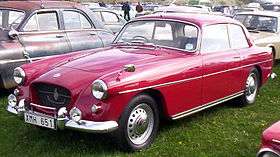Bristol 407
| Bristol 407 | |
|---|---|
 | |
| Overview | |
| Manufacturer | Bristol Cars |
| Production |
1961–1963 88 units |
| Body and chassis | |
| Class | Sport saloon |
| Layout | FR layout |
| Powertrain | |
| Engine | 5130 cc OHV V8 |
| Transmission | 3-speed automatic[1] |
| Dimensions | |
| Wheelbase | 2,896 mm (114.0 in)[1] |
| Length | 4,877 mm (192.0 in)[1] |
| Width | 1,727 mm (68.0 in)[1] |
| Curb weight | 1,651 kg (3,640 lb)[1] |
| Chronology | |
| Predecessor | Bristol 406 |
| Successor | Bristol 408 |
The Bristol 407 was a luxury car found by the press in September 1961[2] and produced by British manufacturer Bristol Cars between 1961 and 1963. It was the first Bristol model to be made under the present administration after their separation from the Bristol Aeroplane Company, which had built all previous Bristol models.
Outwardly it resembled the 406 which had been produced between 1958 and 1961. The only changes were very subtle, comprising a single horizontal bar on the somewhat enlarged radiator grille, which had been steadily increased in size from the 405 to the 406 through to the 407, plus two exhaust pipes instead of one at the rear. However, under the bonnet of the 407 was not the old BMW-derived six-cylinder engine that was now inadequate for Bristols to be able to compete in performance with other British makes of luxury car. Replacing the old six-cylinder engine was a 5,130 cc (313 cu in) Chrysler V8, built in Canada, fitted with a new camshaft and mechanical tappets (lifters) of Bristol design.[3] It re-established Bristol's credentials in the field of performance cars. The engine gave the 407 a maximum speed of over 125 mph (201 km/h).
This engine was mated to a TorqueFlite automatic gearbox as the only transmission option. The transmission had three forward speeds and a torque converter.
The other major change vis-à-vis the 406 lay in the front suspension. Gone were the transverse leaf springs that were inadequate to provide effective handling at the higher speeds which the 407 was capable of; in its place were coil springs. This basic suspension design was to be used on all future eight-cylinder Bristols, though there were to be major refinements from the 603 onwards. Gone also was rack and pinion steering, which inhibited the 407's handling.[4]
The bodywork on the 407 and subsequent models was built by bus body builder Park Royal Vehicles who also did trimming and finishing on some of those produced.[5] A handful of cars received bespoke bodywork, by Viotti and Zagato.
Performance
The British "Motor" magazine tested a 407 in 1961 and recorded a top speed of 125.2 mph (201.5 km/h) and acceleration from 0-60 mph (97 km/h) in 9.2 seconds. A "touring" fuel consumption of 17.5 miles per imperial gallon (16.1 L/100 km; 14.6 mpg‑US) was recorded. On the home market, as tested, it cost £5141 including taxes of £1616.[6]
Notes
- 1 2 3 4 5 "1961 Bristol 407". carfolio.com. Retrieved 1 January 2008.
- ↑ Interest in New Models as Show Season Opens. The Times, Tuesday, Sep 19, 1961; pg. 4; Issue 55190
- ↑ Setright, L. J. K. "Bristol: A Quiet Touch of Class", in Northey, Tom, ed. World of Automobiles (London: Phoebus, 1978), Volume 2, p.235.
- ↑ Setright, p.235.
- ↑ "Park Royal Vehicles".
- ↑ "The Bristol 407". The Motor. 13 September 1961.
External links
| Type | 1940s | 1950s | 1960s | 1970s | 1980s | 1990s | 2000s | 2010s | |||||||||||||||||||||||||||||||||||||||||||||||||||||||||||||||
| 7 | 8 | 9 | 0 | 1 | 2 | 3 | 4 | 5 | 6 | 7 | 8 | 9 | 0 | 1 | 2 | 3 | 4 | 5 | 6 | 7 | 8 | 9 | 0 | 1 | 2 | 3 | 4 | 5 | 6 | 7 | 8 | 9 | 0 | 1 | 2 | 3 | 4 | 5 | 6 | 7 | 8 | 9 | 0 | 1 | 2 | 3 | 4 | 5 | 6 | 7 | 8 | 9 | 0 | 1 | 2 | 3 | 4 | 5 | 6 | 7 | 8 | 9 | 0 | 1 | 2 | 3 | 4 | 5 | 6 | 7 | |
| Saloon & Drophead | 400 | 403 | 406 | 408 | 410 | 412 | Beaufighter / Beaufort | ||||||||||||||||||||||||||||||||||||||||||||||||||||||||||||||||
| 401 / 402 | 404 / 405 | 407 | 409 | 411 | 603 | Britannia / Brigand | Blenheim | ||||||||||||||||||||||||||||||||||||||||||||||||||||||||||||||||
| Sports car | 450 | Fighter | Bullet | ||||||||||||||||||||||||||||||||||||||||||||||||||||||||||||||||||||